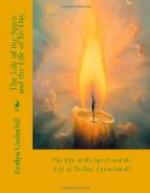If therefore the spiritual or the regenerate life is not likely to prosper without some incorporation in institutions, some definite link with the past, it seems also likely to need for its full working-out and propaganda the symbols and liturgy of a cultus. Here again, the right path will be that of fulfilment, not of destruction; a deeper investigation of the full meaning of cultus, the values it conserves and the needs it must meet, a clearer and humbler understanding of our human limitations. We must also clearly realize as makers of the future, that as the Church has its special dangers of conservatism, cosiness, intolerance, a checking of initiative, the domestic tendency to enclose itself and shirk reality; so the cultus has also its special dangers, of which the chief are perhaps formalism, magic, and spiritual sloth. Receiving and conserving as it does all the successive deposits of racial experience, it is the very home of magic: of the archaic tendency to attribute words and deeds, special power to a priestly caste, and to make of itself the essential mediator between Creative Spirit and the soul. Further, using perpetually as it does and must symbols of the most archaic sort, directly appealing to the latent primitive in each of us, it offers us a perpetual temptation to fall back into something below our best possible. The impulsive mind is inevitably conservative; always at the mercy of memorized images. Hence its delighted self-yielding to traditional symbols, its uncritical emotionalism, its easy slip-back into traditional and even archaic and self-contradictory beliefs: the way in which it pops out and enjoys itself at a service of the hearty congregational sort, or may even lead its unresisting owner to the revivalists’ penitent-bench.




